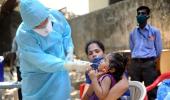'The fight against COVID-19 is not a hospital fight.'
'It's a community level fight.'
'If your community level measures are good, you can decrease the number of people coming to hospitals, or flatten it.'

"If we did not have the lockdown, the number of cases would have been much higher. Five or ten times higher," Dr Randeep Guleria, director of the All India Institute of Medical Sciences, New Delhi, tells Rediff.com Senior Contributor Sheela Bhatt in the first part of an exclusive interview.
What is your view of the medical infrastructure today if compared to pre-COVID-19 days?
If you look at the medical sector, there are two things.
One is, in terms of trying to prepare for a pandemic or an outbreak, which the government and a lot of institutes started, way back in January and February. Seeing the number of cases, and what was happening in China.
Starting from the government screening people, testing -- realising that that would be the need, a lot of things were done.
One is at a national level, to build more and more labs, for testing. So, initially there were very few labs doing viral testing.
That was damn tough. It then became more than a hundred labs. We have now crossed more than 200, 220 labs which can do testing for COVID-19.
Government and institutions also realised that there is need for training.
So a lot of training workshops were held during this time. And also planning for what we will do in case there is an increasing number of cases.
So, from management to equipment to human resources, how can we move human resources from one area to the other?
For doctors who are not in this area, but in other areas. For example, in surgery or in gynacology, how can they help? All that planning was done.
And as the cases started coming in and we had the lockdown, how to make dedicated facilities for COVID-19.
So AIIMS has made one dedicated COVID-19 hospital which is our trauma centre. The trauma centre we have shifted to the other hospital. We've also built another centre in Jhajjar, Haryana.
We have currently about 150 COVID-19 positive patients there.
At our trauma centre, we have now currently seven patients in the ICU.
Italy, Spain and America, even China, have better health infrastructure than India. How do you look at this current event where India is showing better results?
The issue to remember here is that the fight against COVID-19 is not a hospital fight. It's a community level fight.
If you don't do good community level measures, you will have more patients coming into hospitals.
If your community level measures are good, you can decrease the number of people coming to hospitals, or flatten it, thereby the health resources are not going to be strained.
What India did very quickly was start contact tracing, screening and got the lockdown in place very early.
Many countries in Europe and in the US didn't have a lockdown. Many parts of US still don't have a lockdown.
So when official meetings take place where India's scientific brains had to advise government for a lockdown, all of you collectively did not think of this huge population that may go hungry?
The decision that has to be taken is dependent upon us, what we will decide, from a medical point of view.
We have to think of how we can prevent the chain of transmission, how we can prevent a large number of cases coming into hospitals.
Second, it has to be done in a manner where it does not defeat the idea behind it.
So if you want to say that we will do a lockdown in five days's time, then within those five days there will be such a lot of movement that the whole purpose of s lockdown will be defeated.

That would give time to migrant labour to return to their villages...
Then the whole purpose of a lockdown would be lost.
How? Could you explain?
So if you have someone who is carrying the infection, and you say that we will have a lockdown within five days, and in those five days he goes to his village, say from Bombay, which is a hotspot, or from areas where there were a lot of cases.
He/she will carry the infection because he/she is asymptomatic right now. And, eventually, give it to a large number of people in his/her village.
So the lockdown has to be done in an aggressive and immediate manner. What it means is that those who are there at one place will have to stay there.
If I say I will do a lockdown in two weeks's time, and everyone goes all over the place in the country, then already mixing has happened.
The idea is to cut the chain. If not done, then the lockdown is of no use.
This is what has happened in the US to a large extent. The US has done a lockdown in a very slow manner. That is why, from New York, cases have now spread to so many other states.
Because they allowed travel, they allowed people to go. So they (federal and state governments in the US) said you stay at home as one policy, but you can still travel.
If you have to have a lockdown it has to be drastic. That's why drastically international flights were stopped.
I do agree that it is causing a lot of suffering to a number of people, especially to the lower economic strata. But think of it from the point of view of if we had a large number of patients which would have poor people too, people who were carriers would have suffered too.
Taking this disease to the villages, you would have a huge number of cases.
I will give you another indirect example which will make you understand. We have a spike of cases because of one community going all over. They were just in one area, Nizamuddin (in New Delhi), and then they went to large parts of India, and there were a huge number of cases.
Many of them were all positive, and they went... And there was a huge number of cases in different parts of the country wherever they went.
Now imagine if you had people who were of not a particular community, but general who suddenly started going to their villages or home towns, and were also positive, you would have a huge number of cases throughout the country.

Why then is there a spike in the number of patients after 21 days plus of the lockdown?
So, if we did not have the lockdown, the number of cases would have been much higher. Five or ten times higher.
So if you were to look at the doubling time -- how quickly are cases doubling -- there is a graph that the Government of India has issued, it showed that before the lockdown, cases were doubling every third day.
Currently, cases are doubling almost six to seven days.
So if you look at the graph when we were at 500 cases, how long did it take us to reach 1,000 cases? You will see it has almost taken us a week, almost ten days.
That means we have been able to slow the curve.
If you look at what has happened in Italy, and what has happened in New York, how quickly have the cases gone from 1,000 to 2,000, from 2,000 to 4,000, from 4,000 to 8,000.
You will understand that doubling time over there is much more rapid than what has happened in India.
So that is the success of the lockdown. Lockdown will never make cases 0.
It will flatten the curve so that the number of cases flattens. Over a sustained period of time, the numbers will start stabilising and then gradually start coming down.
It's not an on-off switch.
After the lockdown, you will continue to have some cases in the community who will escape from the lockdown and will continue to have some spread.
We could have had a better effect of the lockdown if we did not have a group (members of the Tabligi Jamaat) which went around and caused a large number of cases which is being corrected now because a large number of people had to be traced and quarantined.
That led to a spike. But I think that is now stabilising.

How do you look at this fear that, if and when the lockdown is lifted, a surge can be expected?
So that is a possibility. That's why the exit strategy of how do we come out of the lockdown, how do we do it in a graded manner, how do we do it from areas which are not hotspots compared to areas which are hotspots need to be worked out. And that plan has to be put in place.
But, again, that will depend on different parts of the country, how different parts behave and what strategy we can have for different parts.
I don't think you can have one strategy for the whole country. There were many districts where there are hardly any cases.
And we have some districts or some areas where there are a huge number of cases.
So in a hotspot, or what we call red zones, is there community transmission?
No, I don't think there is enough evidence to suggest there is community transmission.
Hotspots are areas that need a very aggressive lockdown because there there is a chance of community transmission starting.
Currently, you can always trace it to one index case. Because contact tracing is being done aggressively.
But if you have a huge number of cases occurring in one hotspot, as happened in say a slum (Dharavi in Mumbai) area, you are always worried that there will be a large number of transmissions happening, and you have to prevent it from going to another area.
So what do you do? You do an aggressive lockdown in that area, total containment of even asymptomatic people. So that they cannot go out and the disease does not spread beyond that area.
And once the cases in that area start coming down, then you start assessing, can we do some graded movement?
And this is what China has done. There is a whole study that has come out of China, of showing how the lockdown actually brought the cases down.
They looked at hotspots, they did a total quarantine, people were not even allowed to go out even if they were asymptomatic.
And in those hotspots, gradually over a period of time -- and there is data from January to February, 15-15 days -- showing the effect of this aggressive lockdown, how the cases dramatically came down.
We are trying to do that, but there has to be a lot of community participation.










